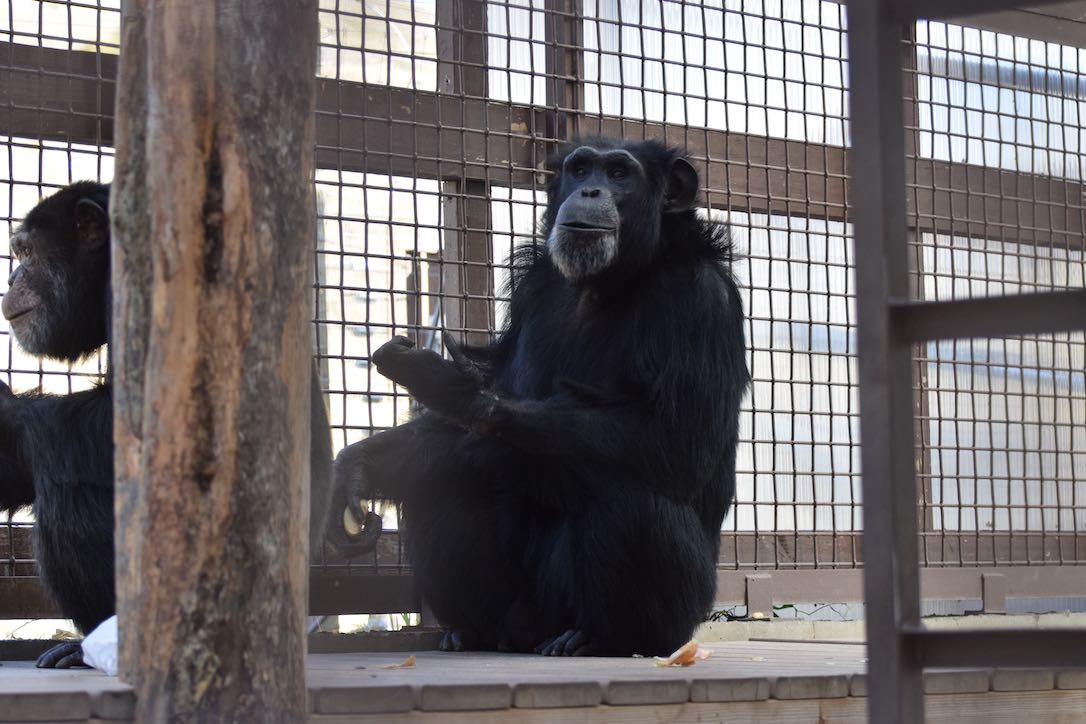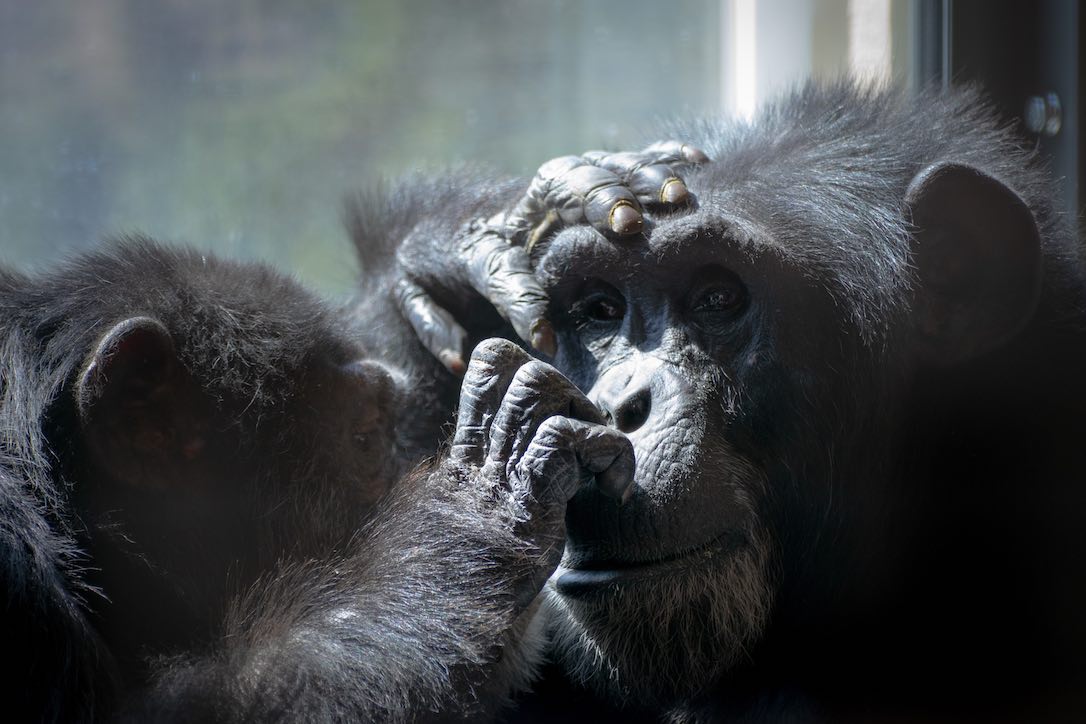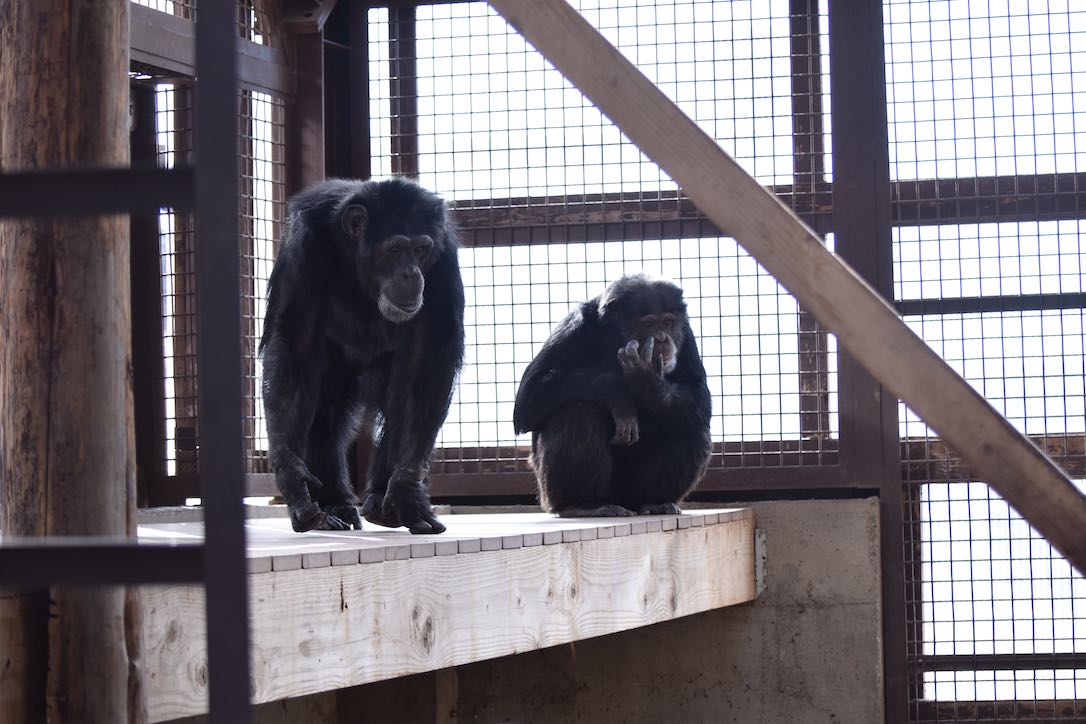Among captive chimpanzees, the concept of dominance can be a bit of an enigma. As we attempt to integrate the two groups of chimpanzee residents here at the sanctuary, we are having many discussions about the dominance hierarchy. Dominance isn’t the only important thing during this stressful time, but it’s still important.
In the Merriam-Webster dictionary, the adjective dominant can be defined as:
- commanding, controlling, or prevailing over all others
- very important, powerful, or successful
- overlooking and commanding from a superior position
These definitions, among others, can each paint a different picture of what it means to “be dominant.” Primatologists tend to use the word in relation to social rank (i.e., where an individual fits within their group’s hierarchy in relation to other individuals). In primates and many other social animals, there is abundant research on the topic of social rank and the benefits that a high rank confers. By having more opportunities to mate and obtain resources, higher-ranking individuals tend to have a greater chance at reproducing and passing on their genetic material. In this way, traits that help an individual achieve a higher social rank can be heavily advantageous. In most primate species, males and females form separate hierarchies and compete within, not between, the sexes. although the resulting structure is often clear, the mechanisms by which dominance hierarchies develop and change are complex.
Studies of free-ranging chimpanzees (e.g., Dr. Jane Goodall’s) have revealed that males and females have somewhat separate social hierarchies. Generally, adult males vie for higher rank using a combination of physical aggression, explosive displays and tactful cooperation. Adult females develop higher rank through experience and tenure. The lowest of the adult males is still usually higher than the highest female. In a community of chimps, males seem to figure out their place in the social hierarchy during adolescence.
Dominance isn’t everything though. A chimpanzee who has a dominant personality may be deficient in other aspects. There’s another component of social rank, perhaps best described as leadership, that seems to affect how long a chimp can hold the rank of alpha after climbing their way to the top. Without an ability to gain the trust of others and manage friendships, a quick, brutal ascension may result in a tragic end. Deposed alpha males can be killed or driven out by their former peers. (For more on this topic, I recommend the fascinating talk by author and primatologist Dr. Frans de Waal.)
If chimps always fought each other in peer-to-peer physical combat, dominance would be easier to study. However, chimpanzees have many ways of diffusing tension and avoiding conflict. They often do this by communicating with one another, thereby establishing boundaries and outlining expectations for how their relationships are going to be in the near future.
Instead of focusing on rare acts of violence, scientists can usually infer social rank by observing pant-grunts. A pant-grunt is a guttural vocalization, often accompanied by an exaggerated bow and/or submissive hand gesture, that is specifically directed from a subordinate towards a perceived superior. It’s a conspicuous overture and leaves little room for debate. When a mother chimpanzee pant-grunts at an adult male, her dependent infant will sometimes pant-grunt in synchrony while clinging to her belly. When a former alpha male concedes that he has lost his position to a rival male, the passing of the torch is usually marked by a conciliatory pant-grunt. Although chimps have numerous cultural traditions that vary between populations, pant-grunts can be heard in almost every chimpanzee social group, captive or otherwise.

The Cle Elum Seven are no different. Burrito, although he lacks a dominant personality and seems uninterested in leadership, sporadically receives pant-grunts from the females (even Jamie). Pant-grunts between the six females are rare, although I sometimes see Negra receive them from her peers. Aside from Negra, who generally avoids drama, we usually infer that Jamie is the most dominant female based on her aggressive demeanor and possessiveness. When a situation gets hairy, Jamie’s side is usually the side to be on. Like Burrito, though, Jamie appears to be a poor leader. As Jake’s study of their dominance hierarchy indicated, Jamie’s excessive dominance and unusual social behavior may actually prevent her from being a good leader.

Rather than constantly beating back rivals and taking their food, an effective leader quashes conflicts before they start and often allows minor transgressions to slide. For example, when the new three arrived, Willy B showed tolerance and tenderness towards his female companions. They, in turn, groomed and acknowledged him. That’s why, as J.B. has often said, we’re hoping that Willy B will step up to be a good alpha, thus providing some stability. So far, Willy B has not revealed himself to be a tyrant or a bully, so he may be the keystone individual that CSNW needs to have a cohesive, stable chimpanzee community.

With Jody, Annie and Missy now in a state of cohabitation with the new three, they have all been cautious and submissive towards Willy B. In turn, Willy has remained stoic amid all the drama. He seems to be equally interested in the new surroundings and still focuses on his favorite foods. He’s observant and reserved, but not overly reactive. All he has to do is sit there and the females will pant-grunt at him anyway. Of course, it sometimes helps to acknowledge their efforts, but he certainly doesn’t over-do it.

Somewhat surprisingly, the other females have also been submissive towards Mave. It’s possible that, in the absence of fellow males, Mave has evolved into Willy’s biggest supporter. She is definitely playing a peacekeeper role, and may be helping Willy B to keep his alpha status. It will be interesting to see whether Burrito and Jamie, who are both relatively dominant, recognize Willy as their leader. There may be some drama before we get to that point, but the goal is to give the chimps what they need to form a sustainable and healthy social group.







